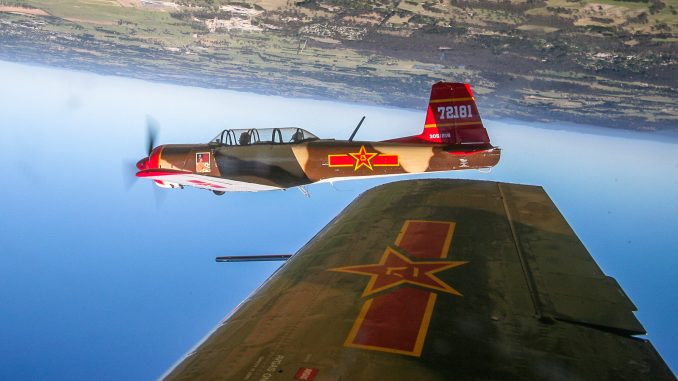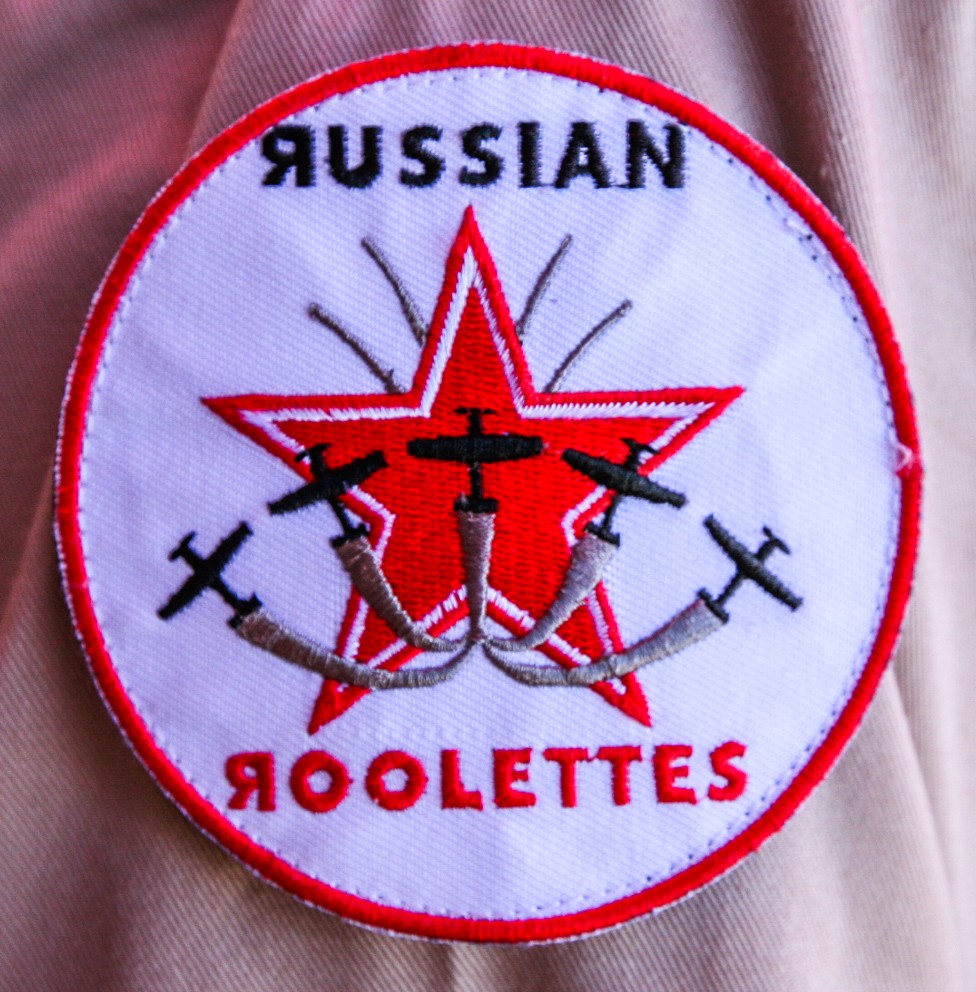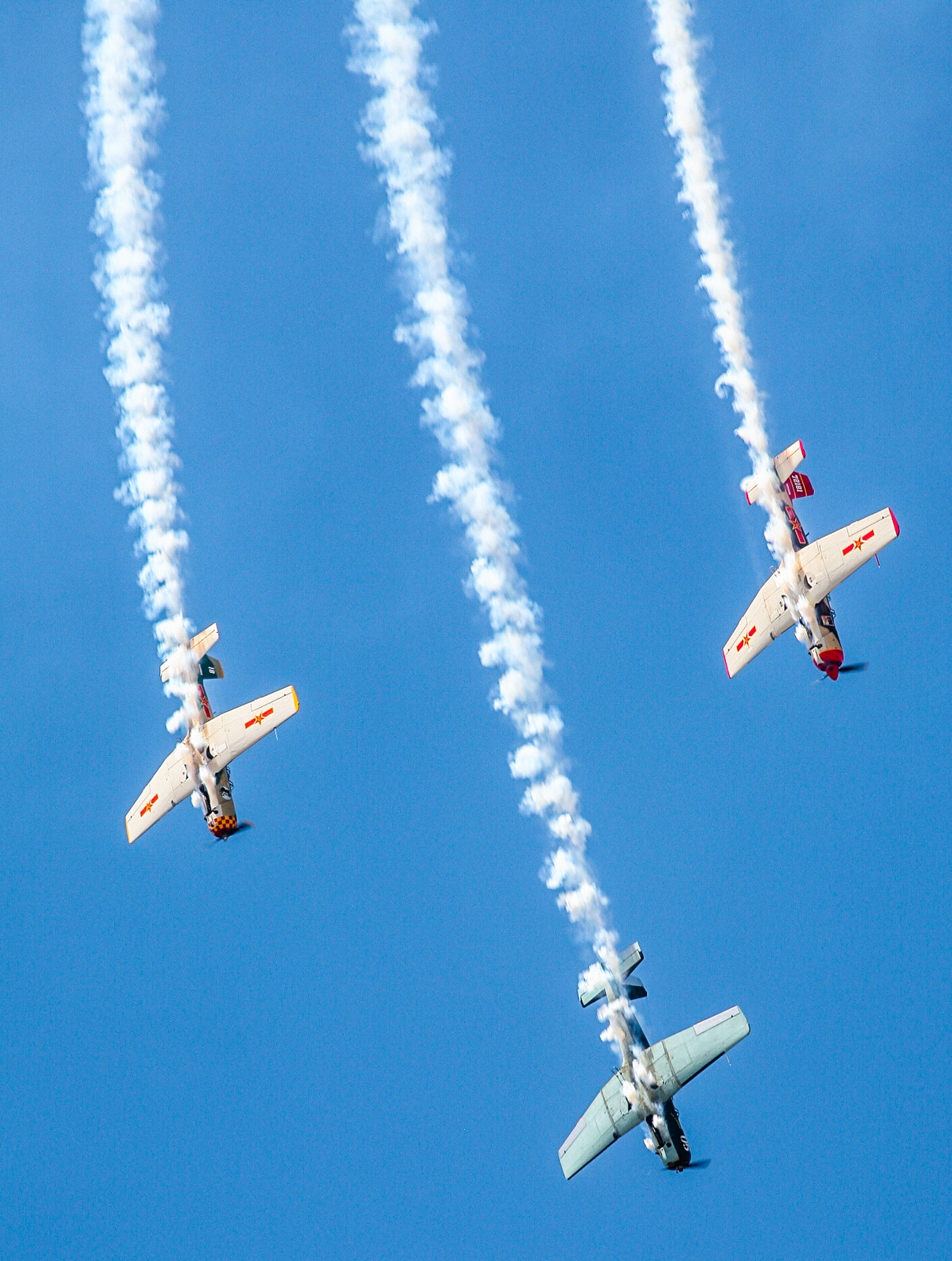
RUSSIAN ROOLETTES – THE RED STAR WARBIRD TEAM
by Phil Buckley
Large scale civilian aerobatics teams are not a common sight anywhere in the world, but in the Southern Highlands of New South Wales, Australia you can find one of these organizations, The Russian Roolettes. Developed over the last twenty years, the sight of these former Eastern Bloc/Russian and Chinese trainers in large formations… rolling, looping and sometimes trailing smoke has become a familiar scene for the public visiting air shows and charity events in Australia.
RED STAR RISING
Lindsay Sinclair kick-started the Russian Roolettes aerobatics team in 1993. He owned and sold Russian aircraft and flew displays with five core pilots at that time. The team’s focus has evolved from the initial few owners of former Soviet warbirds getting together and flying relatively simple passes and ground attack runs, to the highly polished and creative air show acts of the present day. The team’s name, Russian Roolettes, formed “on the fly” as their leader Egon Mahr recalls, “In 1993, Lindsay and his mates flew their aircraft to attend an airshow in Mareeba, Queensland, but having some display practices under their belts, they were asked to fly in place of the RAAF Roulettes who had pulled out on short notice. Lindsay was asked for a team name, and he chose Russian Roolettes – partly in honour of the missing RAAF Roulettes, but of course also to add the flavour of Russian aircraft.” The name Russian Roolettes has since become well known for aviation-minded people around Australia.

HOME BASE MITTAGONG
Most of the team hangar their aircraft at Mittagong airfield, a short drive south of Sydney. Located amongst the open grounds, hangars and a long runway is the Berrima District Aero Club, known to most as the Mittagong Aero Club. This is where all the preflight planning, flying and post-flight debrief action occurs. Currently the team comprises four Yak 52s and two Super Nanchang aircraft. Two new members and their Yak-52 aircraft joined the core four just this past year. Egon Mahr bases his aircraft on his own airfield a few kilometres west of Mittagong, and two other team members house their planes at Camden and the Hunter Valley; flying down to Mittagong for practise sessions.

BEHIND THE STARS
Delving into the background of the team you will find an interesting cross section covering both the military and civil aviation sectors. This blending of experience, skills and knowledge allows for a carefully constructed air show display team and flying routine. Current Russian Roolettes pilots are Egon Mahr, Jim Eaglen, Niall Higgins, Mark Willard, Sean Trestrail and Tim Windsor, with Greg Hewson and Sharon Willard in support. We profile the team members to gain an insight into why they fly and are involved in the team.

Egon Mahr grew up obsessed with aircraft. He worked on weekends and school holidays to pay for flying lessons. He soloed at age 16, had his private pilots license by 17 and was flying in the Royal Australian Air Force by 19. During his time in the RAAF, he flew the BAC 1-11, HS 748, Dassault Mirage, Macchi, CT4 and CAC Wingeel. After nine years of military service, he joined Qantas Airways, where he has been for 26 years, with the last 15 years as Captain on the Boeing 747 and Airbus A330. Egon also found time to become involved with competition aerobatics, winning an Australian title along the way. It was at that time he bought a Sukhoi SU-26 and became fascinated with Eastern Bloc aircraft. Having met Lindsay Sinclair of Red Star Aviation fame, they hatched a plan to build a Super Nanchang from the ground up. Lindsay spent eight months full time working his magic and built arguably the best Nanchang in the southern hemisphere. Lindsay invited Egon and his new aircraft onto the Team in 2002, where he has been happily enjoying display flying ever since.
Jim Eaglen joined the RAAF in 1980 after leaving school. His good mate at school and current team member, Greg Hewson, is responsible for Eaglen getting into aviation, as Hewson convinced Eaglen to join the RAAF alongside him. Eaglen says, “I spent seventeen years in the RAAF, undertaking flying training on the CT4A and Macchi, then operationally flying Mirages, Tornado F3 (on exchange with the RAF), and F/A-18 Hornet. I have been very lucky in my flying career, with many opportunities just presenting themselves along the way”. Eaglen also spent time on the Hawk and Hornet programs. In flying such high performance military jets, Jim was involved in exercises where he recalls, “I was fighting all the major combat aircraft of the era, both Western and Eastern Bloc. I was also lucky enough to go for rides in most of these aircraft, normally during simulated combat missions”. After leaving the military flying, Eaglen joined Qantas where he has flown the Boeing 767, Airbus A330 and A380 (as an instructor pilot). He says, “Egon got me interested in the Yak-52 and the people that love these aircraft”. Eaglen found that the Yak was a great aircraft with a reliable engine, had fighter-like handling, great sound and is relatively cheap to run. Having had a passion for warbirds, Eaglen and Hewson eventually bought their own Nanchang CJ-6 and joined the team.
Mark Willard has come from a background of civil aviation which was spurred on by memories of his father and grandfather who served during WWII. Willard moved to the Southern Highlands twenty six years ago and has found it a terrific community for aviation. He explains, “I attained my private pilot’s licence twenty one years ago and have been flying and restoring aeroplanes ever since”. Willard and his wife Sharon own a Yak-18T – a four-seater – a Cessna 152 and a share in the Yak-52 that Mark flies in the display team. Mark Willard gets immense pleasure from flying, more recently as a member of the team with “the challenge of formation flying, because it is a new skill for me and it requires teamwork and trust. It really takes flying to a new level.” Mark Willard was previously the team manager, but passed the baton last year so that he could concentrate on his display flying.
Niall Higgins emigrated to Australia from Ireland about 25 years ago and has been flying ever since. Among other aircraft such as a Tiger Moth, Higgins co-owns a couple of Yak-52s and is a civilian flying instructor with over 4,000 hours on a wide variety of aircraft. He is also a commercial balloon pilot. He has belonged to the Russian Roolettes since 2008, and is currently the display flying lead.
Sean Trestrail was born in Kenya and emmigrated to Australia in 1969. His father was an ex-RAF Engine Fitter and imbued Sean with a total fascination for aviation from a very early age. Trestrail attained his PPL through an Air Training Corp flying scholarship at age 17, and he joined the RAAF in 1975. After the pilots course on the Winjeel and Macchi, Sean went on to fly Mirages and graduated as a Fighter Combat Instructor. After instructing at the fighter training school (2OCU), Sean went on to the F/A-18. He helped develop the RAAF (and RCAF) Computer Based Training system for the Hornet conversion course with McDonnell Douglas in the USA and returned to join the first home grown Hornet course. Sean joined QANTAS in 1987 after a stint instructing on the Hornet at 2OCU, and has flown the Boeing 767, 747, Airbus A330 and is now Captain on the A380. Jim Eaglen sowed the Yak-52 seed by taking him for a ride. Trestrail has recently purchased a Nanchang and it probably won’t be long before he flies it in the Roolettes, making it 3 Nanchangs and 3 Yak-52s.
Tim (Boggy) Windsor joined the RAAF in 1976 at age 19, and graduated from the pilots course in November, 1977. Initially flying HS748 aircraft, in 1980 he moved to 36 Squadron to fly the C-130H Hercules transport. In 1983, Windsor became the first Australian USAF exchange pilot on the C130 based at Pope Air Force Base in Fayetteville, North Carolina. There he flew missions in Central America, Europe, the Middle East and above the Arctic Circle. He returned to Australia at the end of 1985 to take up a position at 36 Squadron as the Tactical Operations Officer in charge of C-130 low level and special operations. Tim joined QANTAS at the end of 1985 and has flown the Boeing 747 and 767. He is currently a captain on Airbus A330s. He bought his Yak 52 ten years ago, and for the past seven years has been a low level display pilot, often performing at major concerts performed in the Hunter Valley. Windsor flies the “slot” as Roolette 4 in the current display, as well as a solo display.
Greg Hewson is currently the team reserve pilot, manager and commentator. Ex-RAAF, Hewson flew as a navigator in tactical C-130 Hercules missions and subsequently on F-111s. He took up general aviation flying out of RAAF Base Williamtown’s Aero Club at the suggestion of then fighter base commander, now Air Vice Marshal Mel Hupfeld (also an RAAF Academy and pilots course mate of Greg Hewson and Jim Eaglen). Hewson then got talking to Eaglen about his interest in warbirds and they decided to purchase the “super” Nanchang CPX. The term “super” is coined for the team’s two current Nanchangs because they are fitted with the 360HP Russian Vedeneyev M14P engine in lieu of the original 285HP Chinese Housai engine. These are currently the only two super Nanchangs in Australia.
Sharon Willard, aka Svetlana, is the team’s Yak-18T pilot which sees her flying all the team equipment to events. Sharon says “I help out also with the commentary at airshows, paperwork and other administration, including organising team music, linking of course with the commentary”.

TEAM BRIEIFINGS AND AIRSHOW PLANNING
One of the first things one notices when attending a flight briefing is that the team members are all focused on ensuring that their flying program is safe. Each air show training flight and display is built around safety first, formation and aerobatic manoeuvres second. Preparation involves numerous considerations, starting from pilot skills and currency and aircraft performance, but also airfield layout, axis of the display, crowd lines, wind direction and any local terrain obstacles. After briefing and before flying, the team forms up around a mock-up of the ground they will be flying the display over and “walk through” their routine until they are satisfied that they have locked in their routines as elements and as a coordinated team. This includes their manoeuvres, flying parameters, formation positions, hand signals and radio communications if needed, sight pictures for aircraft rejoins, any flying risks and contingencies, through to justifications for “knocking-it-off” (ceasing their display immediately and returning to land). In short, they replicate their display on the ground until all aspects are fully understood by all teammates and any issues resolved that may have been overlooked in the pre-flight briefing. The team’s golden rule is that nothing can be flown in the air that has not been previously practised, briefed and walked through on the ground. All the team members have full right – in fact, an expectation – to raise even the smallest question mark. Once satisfied that they have full situational awareness, the team will walk out to their aircraft, pre-flight and give each other the thumbs-up “ready to start”. From there, the rest of us get to be enthralled by the sight of these wonderful warbirds, the sound of their powerful radial engines, and the precision and choreography of their display. Crowds have been captivated as they separate into smaller elements and fly a range of formation and criss-crossing aerobatic manoeuvres, sometimes with power and grace, other times very dynamically, even hair-raising!
PRACTISE, PRACTISE, PRACTISE
The team tries to meet as a group once a month for practise sessions at the airfield, although team members will practise some component of their display on most weekends. Of course, the team would ideally like to keep current through participating at numerous air shows, back-to-back across Australia!
Jim Eaglen and Egon Mahr are approved to fly their aerobatics down to 200ft, while the main display formation is flown at around 800-1,000ft with a floor of 500ft. As they are flying in close formation at about 10 feet apart, the right skills, trust and concentration are critical. Australia’s Civil Aviation Safety Authority provides individual pilot approvals, but also require approvals for every team display. The displays are adjusted for the pilots participating, any specific air show constraints, or simply to change up or expand the display. Each display builds upon the last, with any refinements or changes developed, agreed by the pilots, written up with a risk assessment and passed to CASA for review and approval.
The average display is around twelve minutes and includes a series of smaller element displays such as formation passes, sometimes with an aircraft inverted, pair loops and barrel rolls, pair opposition passes and split breaks, an aircraft manoeuvring around a formation, solo aerobatics and a bomb burst finale. These passes and display elements are coordinated so that the crowd is never without something going on in front of them. The pilots also select “smoke on” at times to heighten the display presentation, but smoke also provides a very useful visual aid for the team members to pick each other up during such as opposition passes and formation rejoins particularly.
THE WARBIRDS
It is interesting having two different aircraft types fly formation rather than one. Both the Yak-52 and Nanchang CJ-6 originated in the 1960s and are tandem-seat, low wing trainers for military fighter pilots. The aircraft are reliable, can operate from hard runways as well as unimproved grass strips and they are aerobatic. With a shorter straight wing, the Yak-52 is a little more nimble, rated to plus 7G and minus 5G and has a faster roll rate, whereas the slightly gull-winged Nanchang is a little less manoeuvrable at plus 6G and minus 4G, but it is a little more slippery and can gain energy more easily. Mixing two aircraft in close formation does add challenges to the pilots, but good training and thoughtful arrangement of the display sequence and transitions resolves these issues.
ONBOARD WITH THE ROOLETTES
The author was invited to see first hand the professionalism and dedicated team work of the Russian Roulettes, on the ground and in an element of their formation from a back seat. Having witnessed team briefings and practices from the ground, to attain some appreciation I joined Jim Eaglen in his Nanchang, while Egon Mahr flew alongside in his Nanchang and Niall Higgins in his Yak-52. Team radio chatter was kept to a minimum as they focused on smooth, close flying, formation station changes (including in echelon and line astern), loops and other manoeuvres separated by only a few yards. Most of the flying took place at around 180 knots which was enough to maintain the energy required in the more dynamic manoeuvres. It was fabulous fun!
AIRSHOWS AND FUTURE EVENTS
The team has flown as far as Queensland (Wide Bay Airshow Bundaberg primarily) and Southern Australia, but mainly keep their displays to within New South Wales. The team appeared at a lot of regional airshows in 2013 such as the Narromine Ausfly, Inverell, Gunnedah, Tamworth Festival of Flight and Temora Warbirds Downunder. In early 2014, the team featured on the 2014 Aviation Insurance leaflet which will help to sell warbird insurance policies. The 2014 airshow season was not as strong as it had been in recent years, although in October the team was the headline act at Tamworth’s Festival of Flight air show event again and they are all looking forward to wowing the public and aviation enthusiasts more often in 2015 and beyond. The team will be flying in Sydney Harbour for Australia Day this year – although this will not be aerobatic formation but instead general formation flypasts.
The Russian Roolettes has the following Australian air show performance schedule for 2015:
June 20 Moree Airshow
July 4/5 Hunter Valley Airshow Maitland
Sept 4/5/6. Ausfly Narromine.
Sept26/27 Airlie Beach Airshow
Oct 4 Port Macquarie Airshow
Nov 14/15 Armidale Airshow
Nov 20/21 Temora Airshow
WarbirdsNews wishes to thank Phil Buckley for this fascinating insight into an aerobatics display team, and to the members of the Russian Roolettes for their participation. We wish them continued success!




















Great article promoting warbirds down under ( oz style!) it was good to know that fellow RAAF members I know – Jim, Greg and ‘ boggy’ windsor are out there doing this.
For anyone reading who would like to come for a ride in a warbird and do similar flying , go look at Combat Flights Melbourne’ website where you can do this in a two CJ6 aircraft formation over Port Philip Bay and experience a ‘ mock’ combat flight. Well written Phil !
Whoa. Moree hosted an amazing air show on Saturday 20th June, 2015. The show was amazing and something our community will talk about for many years to come. Anyone out there that has the opportunity to attend any of the future shows, do not miss them. I am not a naturally aeronautical person, but I was messmerised with the ability of these amazing pilots. Jaw dropping routines, our community is in awe. Thank you Paul Bennet, Russian Roolettes and their awesome teams. Thank you major sponsors that allowed for this to occur. Katrina Humphries – Moree Plains Shire Council